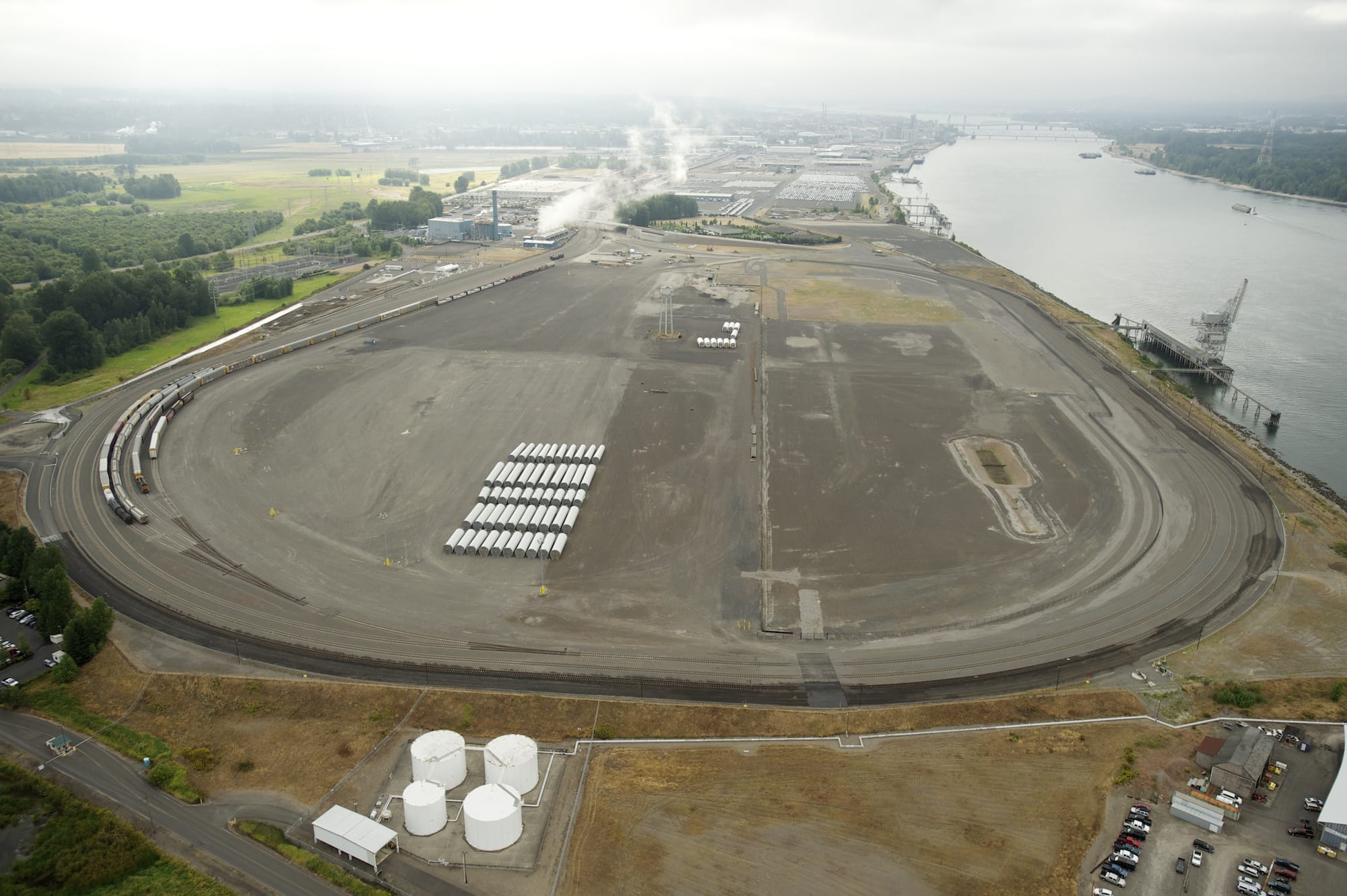The executives behind a joint venture to build the Northwest’s largest oil-by-rail transfer facility in Vancouver swept into the city in a show of support of their controversial project, including meeting privately with business and government leaders and testifying before Port of Vancouver commissioners Tuesday.
However, the Tesoro Corp. and Savage Companies officials also ran into a sustained and growing wave of public opposition to their proposal to build a $110 million oil transfer terminal capable of handling 380,000 barrels of crude per day at the port.
In the latest developments on a proposal that roils the community:
o Company executives criticized what they say are positions taken “prematurely” against the oil terminal.
o At least 60 people packed the port commission’s hearing room, with all but a few of the 35 or more who spoke assailing the oil terminal on multiple fronts.
o Port commissioners received full details of a rail safety study that finds a very low likelihood of a train derailment on tracks beside a $1.3 billion waterfront redevelopment project.
Meanwhile, the state Energy Facility Site Evaluation Council, which is reviewing Tesoro-Savage’s permit application, said Tuesday it will conduct a work session next week in Vancouver to consider a scope of environmental review for the proposed terminal.
Although EFSEC’s meeting is open, the agency will not take public testimony. “Potential environmental impacts of the project will be discussed,” the agency said in a news release. The agency’s meeting will be at 1 p.m. Wednesday, April 2, in hearing room 680 of the Clark County Public Services Center, 1300 Franklin St.
Tesoro and Savage executives told The Columbian early Tuesday that the EFSEC process should be allowed to play out before people take positions on the oil terminal. “What I hope is that people allow the process to bear itself out,” said Nathan Savage, senior vice president of Savage. “I think there are those that have rushed to judgment prematurely. I think that’s unfortunate.”
He was joined by four other executives on the visit, a week after a majority of Vancouver City Council members publicly confirmed their opposition to the proposed oil-handling facility.
During the port commission’s public hearing, opponents praised the four of seven city councilors who’ve staked a position against the oil terminal.
Dan Serres, conservation director for Columbia Riverkeeper, said those councilors made an “enlightened” decision based on information that’s turned up since port Commissioners Nancy Baker, Jerry Oliver and Brian Wolfe unanimously approved the lease with Tesoro-Savage. If anyone’s looking “for the group that made a premature decision,” Serres said, speaking to the port commissioners, “I think you (need to) look into the mirror.”
Tuesday’s developments underscore the multi-faceted nature of the Tesoro-Savage proposal. It’s touched off a litany of local and global arguments over everything from jobs and oil spills to climate change and U.S. energy independence.
‘Not either-or’
One high-profile voice against the oil terminal is Barry Cain, president of Gramor Development — a member, along with Vancouver investors, of Columbia Waterfront LLC — who is promoting a $1.3 billion downtown waterfront revitalization project. Citing a host of concerns, Cain says his development will largely be ruined if the oil terminal wins approval.
Keith Casey, Tesoro’s senior vice president of strategy and business development, told The Columbian that top Tesoro and Savage officials have not met with Cain.
The companies believe Cain’s relationship is with Vancouver and the port, and they shouldn’t encroach on that, Savage said.
But the executives made it clear they don’t agree with Cain’s argument pitting the oil terminal against his waterfront development. “It is not an either-or (decision),” Savage said.
Cain fired back Tuesday, saying he and local project backers have been trying to fulfill the city’s vision of increasing the livability of downtown and bringing more people downtown. “Is having oil trains going through there 24 hours a day going to help that? No,” he said. “Anybody will see that that’s a big, big negative, and it’s going to turn a lot of people off. It’s a huge step back for the city of Vancouver.”
Cain’s waterfront project, which will take advantage of infrastructure investments by the city and the port, is less than 2 miles east of the proposed oil terminal, and next to port and BNSF Railway lines.
But Savage and others noted that the port and nearby railroads have been on the Columbia for more than 100 years.
“I guess to me the question is, what’s changed? The port was planning to grow. It put in the infrastructure to grow,” said Tesoro vice president of corporate affairs Brian Sullivan. “We believe this project is an excellent fit with the port, and so what’s changed?”
“What’s changed?” responded Cain. “They’re wanting to bring dangerous oil cars through there 24 hours a day that are derailing and blowing up all over the country. That’s change. That’s a big, big change.”
The Tesoro-Savage facility would be the largest oil-handling terminal in the Northwest. But it wouldn’t bring an unfamiliar commodity into the region, Sullivan said. “Oil trains go by there today,” he said. “They’re going to go by there tomorrow, and in the foreseeable future.”
Cain said the oil trains that are already passing through the city are only part of the story. The number of oil trains moving through now isn’t “5 percent of what they’re trying to get approved coming through to the Port of Vancouver,” Cain said. “It’s nothing to what they’re trying to increase it to be.”
As to his relationship with Tesoro-Savage, Cain said that early on “we met with” a Savage official but that he and his project partners haven’t met with Tesoro. A Tesoro attorney sent Cain an email a week ago to set up a meeting, Cain said, but they couldn’t come up with a mutually agreeable time.
‘Stranded assets’
Savage told The Columbian that it was important for people to let the EFSEC process take its course. “Probably the best thing for all would be, let’s slow down the rhetoric, lower the emotion levels, and let’s have rational, fact-based discussions,” he said. “We’re more than happy to engage in reasonable productive debates.”
Savage and Casey both testified before port commissioners Tuesday during a public hearing that saw at least 60 people jam the port’s offices. The oil terminal will be built and operated in a safe and environmentally sound way, Casey said.
The proposed facility would generate 250 temporary construction jobs and 120 permanent jobs, according to the companies, and boost local and state tax revenues.
But the hour-and-a-half or so of public testimony delivered to port commissioners Tuesday was, once again, overwhelmingly against the oil terminal. People raised concerns including:
o Lowered property values.
o Global climate change.
o The volatility of Bakken crude.
o Tesoro’s tarnished safety record — including the 2010 explosion at a Tesoro refinery that killed seven people.
o The impact of new toxic air emissions on residents who live near the port.
o Detrimental impacts to Cain’s waterfront project.
o Oil spills.
Some urged port commissioners to cancel the lease. Vancouver resident Don Steinke told port commissioners that the Harney Heights Neighborhood Association and the Maplewood Neighborhood Association are the latest Vancouver neighborhood groups to go on the record as opposing the oil terminal. Steinke also said several hundred residents have signed a petition against it.
He urged commissioners to back out of the lease so that Vancouver doesn’t become “the oil storage capital of the Northwest.”
Another person who testified to commissioners, Tedine Roos, said the companies’ claim that the oil terminal will help deliver U.S. energy independence is shaky at best. The U.S. ban on crude oil exports “can be swept away faster than you can say ExxonMobil,” Roos said.
Eric Strid, a White Salmon resident and retired technology company CEO, told commissioners he lives “within the blast zone” where the oil trains will act as “rolling bombs.” He said the port’s lease to handle oil is behind the times, with renewables becoming cheaper, companies like Boeing embracing biofuels and West Coast government leaders moving to set a surcharge on the use of carbon.
“You’re headed for stranded assets here,” Strid said.
After the public comment, commissioners received the full details of a rail safety study, commissioned by the port and conducted by TUV Rheinland, that found a very low likelihood of a train derailment on a key segment of the port’s rail corridor next to Cain’s planned waterfront development.
The study — which involved extensive computer modeling and analyses of scenarios involving oil, grain and potash trains — focuses on a 3,000-foot-long segment of the port’s rail corridor that begins just west of Columbia Street.
TUV Rheinland concluded that, based on “in-train force and vehicle dynamics analyses,” the proposed operation and track configuration is “well within industry safety standards” and poses “a low risk of derailment.”
The port asked for suggestions to increase safety, so TUV Rheinland made several recommendations, including a high guard rail at one spot and a “double guard rail on the connection track” between a turnout and the BNSF overhead bridge “to further lessen the potential of derailment and damage.”
With those measures, said Sebastian Oertel, chief operating officer of TUV Rheinland Rail Services, the 3,000-foot segment will have a “very low risk of derailment.” What the port is doing goes “above and beyond what we see in the industry,” Oertel said.
The port estimates the additional safety enhancements will cost $500,000. The work will begin in the fourth quarter of this year, the port says, and be completed by early 2015. Curtis Shuck, the port’s director of economic development and facilities, said the same third-party examination given to the 3,000-foot-long rail segment will be given to “the rest of our rail program.”





